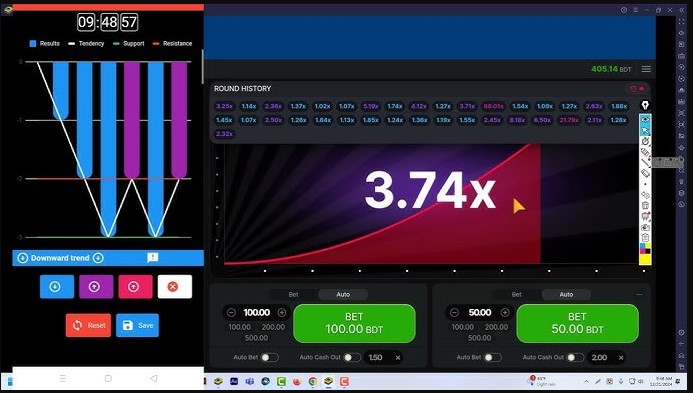The Aviator game is a fast-paced online betting game that has gained immense popularity in recent years, especially on crypto casinos and mobile gaming platforms. With its simple design and adrenaline-pumping gameplay, Aviator attracts players who enjoy quick decision-making, risk-reward dynamics, and statistical thinking.
Table of Contents
At the heart of the game lies a graph that dictates every round — a constantly rising multiplier that can “fly away” at any moment. Understanding this Aviator game graph is crucial for improving your chances of winning, avoiding unnecessary losses, and developing a sound strategy.
In this article, we’ll explore:
- What the Aviator graph represents
- How it works
- Patterns to observe
- Strategies to consider
- Statistical analysis using tables and probabilities
What Is the Aviator Game?
The Aviator game is built on a simple concept:
A plane (or curve) takes off with a multiplier that starts at 1.00x and increases over time. The longer it flies, the higher the multiplier goes — until it suddenly flies away (crashes). If you cash out before it disappears, you win your stake multiplied by the current multiplier. If not, you lose your stake.
The multiplier increases rapidly at first but could crash at any point — even as early as 1.01x.
How the Aviator Graph Works
The Aviator graph visually shows the plane’s progress in real time. As the multiplier increases, the curve rises, giving the player a sense of how much their bet is worth if cashed out now.
Key elements:
- X-Axis (Time): Represents how long the round lasts
- Y-Axis (Multiplier): Indicates the current multiplier
- Crash Point: The moment when the multiplier stops, and the round ends
Interpreting the Graph: Patterns & Probabilities
Although the Aviator game uses a provably fair random algorithm, players try to identify patterns by analyzing historical crash points. The multiplier follows a pseudo-random generation mechanism, but players believe they can gain a small edge by observing trends.
Sample Multiplier Outcomes Over 10 Rounds
| Round | Crash Multiplier |
|---|---|
| 1 | 1.06x |
| 2 | 1.85x |
| 3 | 2.14x |
| 4 | 1.01x |
| 5 | 4.78x |
| 6 | 20.31x |
| 7 | 1.33x |
| 8 | 3.10x |
| 9 | 1.07x |
| 10 | 7.60x |
This table illustrates the randomness of outcomes. However, players often try to detect:
- Low streaks: Several multipliers below 2x
- High burst: A spike above 10x or 20x
- Pattern reversal: Sudden shift from low to high (or vice versa)
While the graph may show these patterns, it’s essential to remember that past outcomes do not guarantee future results.
Mathematical Insight: Expected Values and Risk
To understand your expected return, you need to calculate the break-even multiplier and potential profit margins. Let’s say you always cash out at 2.00x.
Win Probability for Set Multipliers
| Cashing Out at | Estimated Win Probability | Break-even Chance (%) |
|---|---|---|
| 1.10x | ~95% | High |
| 2.00x | ~48% | Medium |
| 5.00x | ~20% | Low |
| 10.00x | ~10% | Very Low |
Note: These probabilities vary by platform but represent general approximations.
The higher you aim, the lower your chances of success — but the greater the reward.
Common Aviator Game Strategies
1. Low-Risk Strategy: Early Cash-Out
- Target Multiplier: 1.20x – 1.50x
- Goal: Secure consistent small profits
- Risk: May miss large multipliers
2. Medium-Risk Strategy: Balanced Play
- Target Multiplier: 2.00x – 3.00x
- Goal: Achieve moderate returns with acceptable risk
- Use of History: Watch for low rounds, then aim for mid-range cash-outs
3. High-Risk Strategy: Big Wins or Bust
- Target Multiplier: 5.00x or higher
- Goal: Catch rare high-multiplier rounds
- Risk: Frequent losses, but occasional large wins
Comparison of Aviator Strategies
| Strategy Type | Cash-Out Point | Win Rate | Avg. Profit (per win) | Risk Level |
|---|---|---|---|---|
| Low-Risk | 1.20x | High (80–95%) | Low | Low |
| Medium-Risk | 2.00x | Moderate | Moderate | Medium |
| High-Risk | 5.00x+ | Low (10–20%) | High | High |
Each strategy appeals to a different personality type — cautious players prefer consistency, while aggressive players seek jackpots.
Graph Analysis Tools and Tips
- Avoid betting after long streaks of high multipliers (regression to the mean)
- Look for streaks of 1.01x — these often indicate a high multiplier is coming soon
- Use dual-bet strategies: place two bets at different cash-out targets (e.g., 1.50x and 5.00x)
Graph Reading Example
Let’s say the last five rounds were: 1.04x, 1.08x, 1.02x, 1.12x, 1.01x.
A low-risk player may bet higher in the next round expecting a “correction” (e.g., a 3x+ round). But again, the outcomes are random, so this is speculative.
Using Autoplay and Auto Cash-Out Features
Modern Aviator games include features like:
- Auto-Bet: Automatically places the same stake every round
- Auto Cash-Out: Automatically exits at a preset multiplier
These help maintain discipline and avoid emotional decisions. For instance, if your strategy is to always cash out at 2.00x, using auto cash-out eliminates second-guessing.
Psychological Tips: Avoiding Emotional Play
The Aviator graph can create intense psychological pressure — especially when you see a multiplier rising after you’ve cashed out too early, or crashing just before your target.
Tips to Stay Grounded:
- Set a budget for your gaming session and stick to it
- Don’t chase losses — focus on long-term patterns
- Take breaks if you feel frustrated or euphoric
- Use fixed bet sizes to avoid overexposure
Emotional Triggers and Responses
| Situation | Emotional Reaction | Suggested Action |
|---|---|---|
| Cashed out at 2x, it goes to 50x | Regret, FOMO | Accept your strategy, stay focused |
| Crash at 1.01x | Anger, disbelief | Recognize randomness, move on |
| 3 wins in a row | Overconfidence | Stay disciplined |
| 5 losses in a row | Tilt, frustration | Lower bets, pause if needed |
The Aviator game graph may look like a simple curve, but behind it lies a complex mix of probability, psychology, and decision-making. While it’s impossible to predict exactly when the plane will crash, understanding how the graph behaves can give you better control over your strategy and risk.
The key to winning in Aviator isn’t just about chasing high multipliers — it’s about knowing when to fly and when to land. Whether you’re a conservative player or a thrill-seeker, understanding the game graph and using data-driven strategies will help you play smarter and stay in the game longer.


